Analysis of Contemporary Issues in Health and Social Care: A Report
VerifiedAdded on 2023/01/12
|13
|4429
|58
Report
AI Summary
This report delves into contemporary issues in health and social care, focusing on the critical topic of female genital mutilation (FGM). It begins with an introduction to health and social care services, emphasizing the need for effective healthcare strategies and policies. The report then presents a case study of Sasha, a woman who underwent FGM at a young age, detailing the physical, psychological, and social consequences she faced. It examines the socio-economic, political, and cultural factors contributing to this health issue, providing a comprehensive analysis of the challenges and impacts. The report further explores service provision in light of this issue, the factors related to Sasha's health condition, and potential strategies for addressing the problems associated with FGM. The report concludes by highlighting the importance of understanding the complexities of these issues to develop effective interventions and support for affected individuals. The report is a valuable resource for students on Desklib.
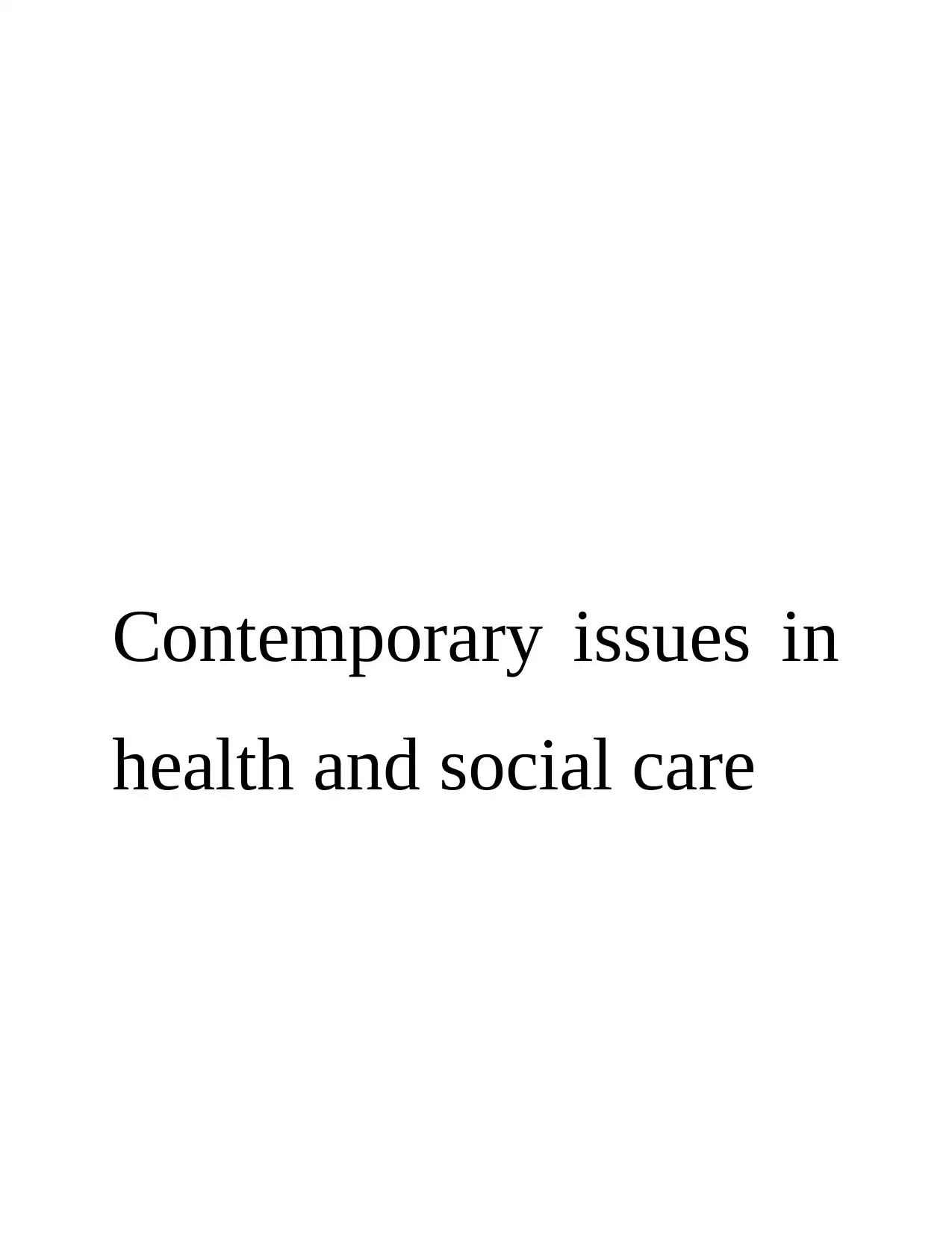
Contemporary issues in
health and social care
health and social care
Paraphrase This Document
Need a fresh take? Get an instant paraphrase of this document with our AI Paraphraser

Table of Contents
INTRODUCTION...........................................................................................................................3
CASE STUDY.................................................................................................................................4
FACTORS RELATED TO THIS HEALTH ISSUE.......................................................................5
ANALYSIS OF SASHA’S HEALTH CONDITION......................................................................5
SERVICE PROVISION IN LIGHT OF THIS ISSUE....................................................................5
ADDRESSING THE ISSUES.........................................................................................................5
CONCLUSION................................................................................................................................5
REFERENCES................................................................................................................................6
INTRODUCTION...........................................................................................................................3
CASE STUDY.................................................................................................................................4
FACTORS RELATED TO THIS HEALTH ISSUE.......................................................................5
ANALYSIS OF SASHA’S HEALTH CONDITION......................................................................5
SERVICE PROVISION IN LIGHT OF THIS ISSUE....................................................................5
ADDRESSING THE ISSUES.........................................................................................................5
CONCLUSION................................................................................................................................5
REFERENCES................................................................................................................................6
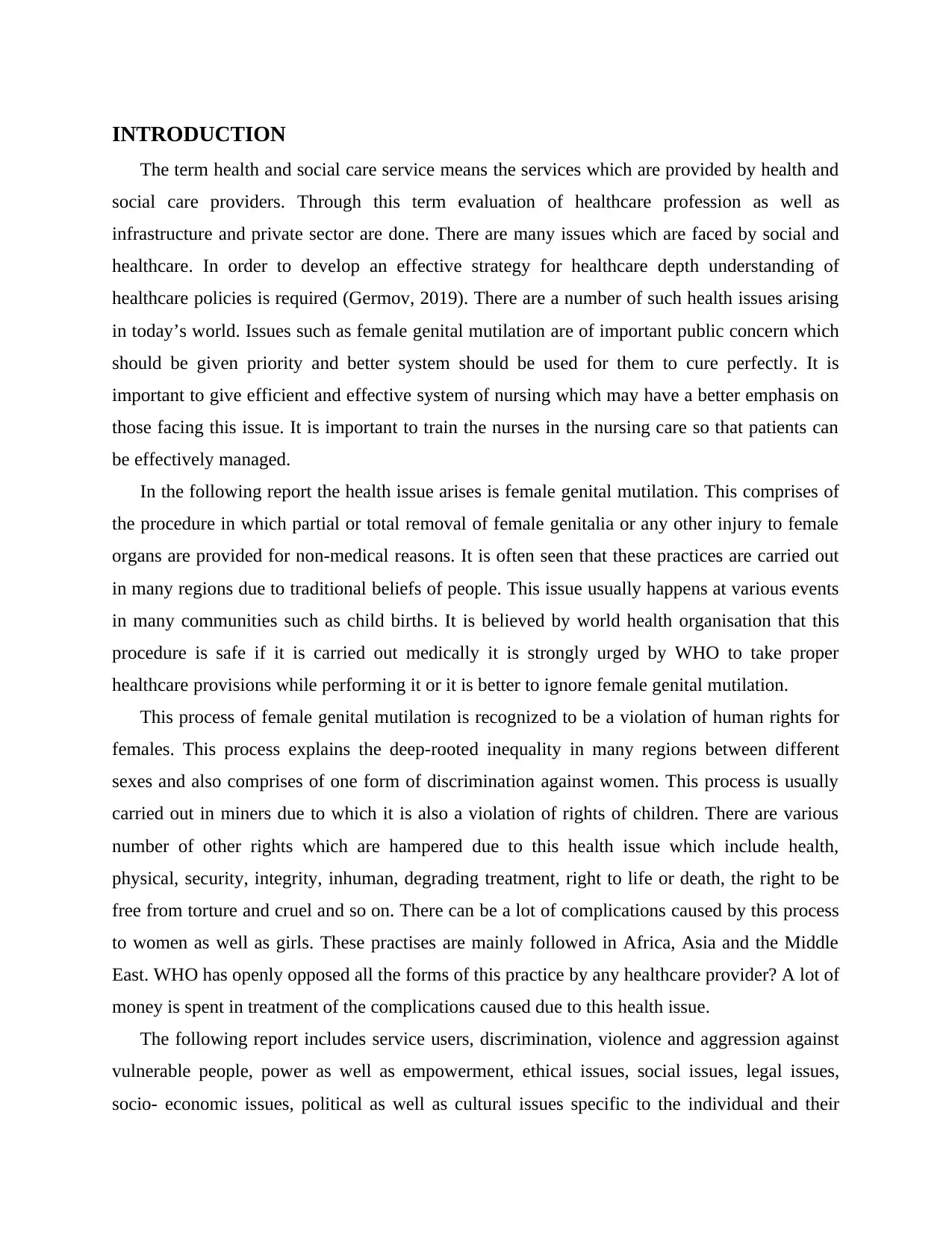
INTRODUCTION
The term health and social care service means the services which are provided by health and
social care providers. Through this term evaluation of healthcare profession as well as
infrastructure and private sector are done. There are many issues which are faced by social and
healthcare. In order to develop an effective strategy for healthcare depth understanding of
healthcare policies is required (Germov, 2019). There are a number of such health issues arising
in today’s world. Issues such as female genital mutilation are of important public concern which
should be given priority and better system should be used for them to cure perfectly. It is
important to give efficient and effective system of nursing which may have a better emphasis on
those facing this issue. It is important to train the nurses in the nursing care so that patients can
be effectively managed.
In the following report the health issue arises is female genital mutilation. This comprises of
the procedure in which partial or total removal of female genitalia or any other injury to female
organs are provided for non-medical reasons. It is often seen that these practices are carried out
in many regions due to traditional beliefs of people. This issue usually happens at various events
in many communities such as child births. It is believed by world health organisation that this
procedure is safe if it is carried out medically it is strongly urged by WHO to take proper
healthcare provisions while performing it or it is better to ignore female genital mutilation.
This process of female genital mutilation is recognized to be a violation of human rights for
females. This process explains the deep-rooted inequality in many regions between different
sexes and also comprises of one form of discrimination against women. This process is usually
carried out in miners due to which it is also a violation of rights of children. There are various
number of other rights which are hampered due to this health issue which include health,
physical, security, integrity, inhuman, degrading treatment, right to life or death, the right to be
free from torture and cruel and so on. There can be a lot of complications caused by this process
to women as well as girls. These practises are mainly followed in Africa, Asia and the Middle
East. WHO has openly opposed all the forms of this practice by any healthcare provider? A lot of
money is spent in treatment of the complications caused due to this health issue.
The following report includes service users, discrimination, violence and aggression against
vulnerable people, power as well as empowerment, ethical issues, social issues, legal issues,
socio- economic issues, political as well as cultural issues specific to the individual and their
The term health and social care service means the services which are provided by health and
social care providers. Through this term evaluation of healthcare profession as well as
infrastructure and private sector are done. There are many issues which are faced by social and
healthcare. In order to develop an effective strategy for healthcare depth understanding of
healthcare policies is required (Germov, 2019). There are a number of such health issues arising
in today’s world. Issues such as female genital mutilation are of important public concern which
should be given priority and better system should be used for them to cure perfectly. It is
important to give efficient and effective system of nursing which may have a better emphasis on
those facing this issue. It is important to train the nurses in the nursing care so that patients can
be effectively managed.
In the following report the health issue arises is female genital mutilation. This comprises of
the procedure in which partial or total removal of female genitalia or any other injury to female
organs are provided for non-medical reasons. It is often seen that these practices are carried out
in many regions due to traditional beliefs of people. This issue usually happens at various events
in many communities such as child births. It is believed by world health organisation that this
procedure is safe if it is carried out medically it is strongly urged by WHO to take proper
healthcare provisions while performing it or it is better to ignore female genital mutilation.
This process of female genital mutilation is recognized to be a violation of human rights for
females. This process explains the deep-rooted inequality in many regions between different
sexes and also comprises of one form of discrimination against women. This process is usually
carried out in miners due to which it is also a violation of rights of children. There are various
number of other rights which are hampered due to this health issue which include health,
physical, security, integrity, inhuman, degrading treatment, right to life or death, the right to be
free from torture and cruel and so on. There can be a lot of complications caused by this process
to women as well as girls. These practises are mainly followed in Africa, Asia and the Middle
East. WHO has openly opposed all the forms of this practice by any healthcare provider? A lot of
money is spent in treatment of the complications caused due to this health issue.
The following report includes service users, discrimination, violence and aggression against
vulnerable people, power as well as empowerment, ethical issues, social issues, legal issues,
socio- economic issues, political as well as cultural issues specific to the individual and their
⊘ This is a preview!⊘
Do you want full access?
Subscribe today to unlock all pages.

Trusted by 1+ million students worldwide
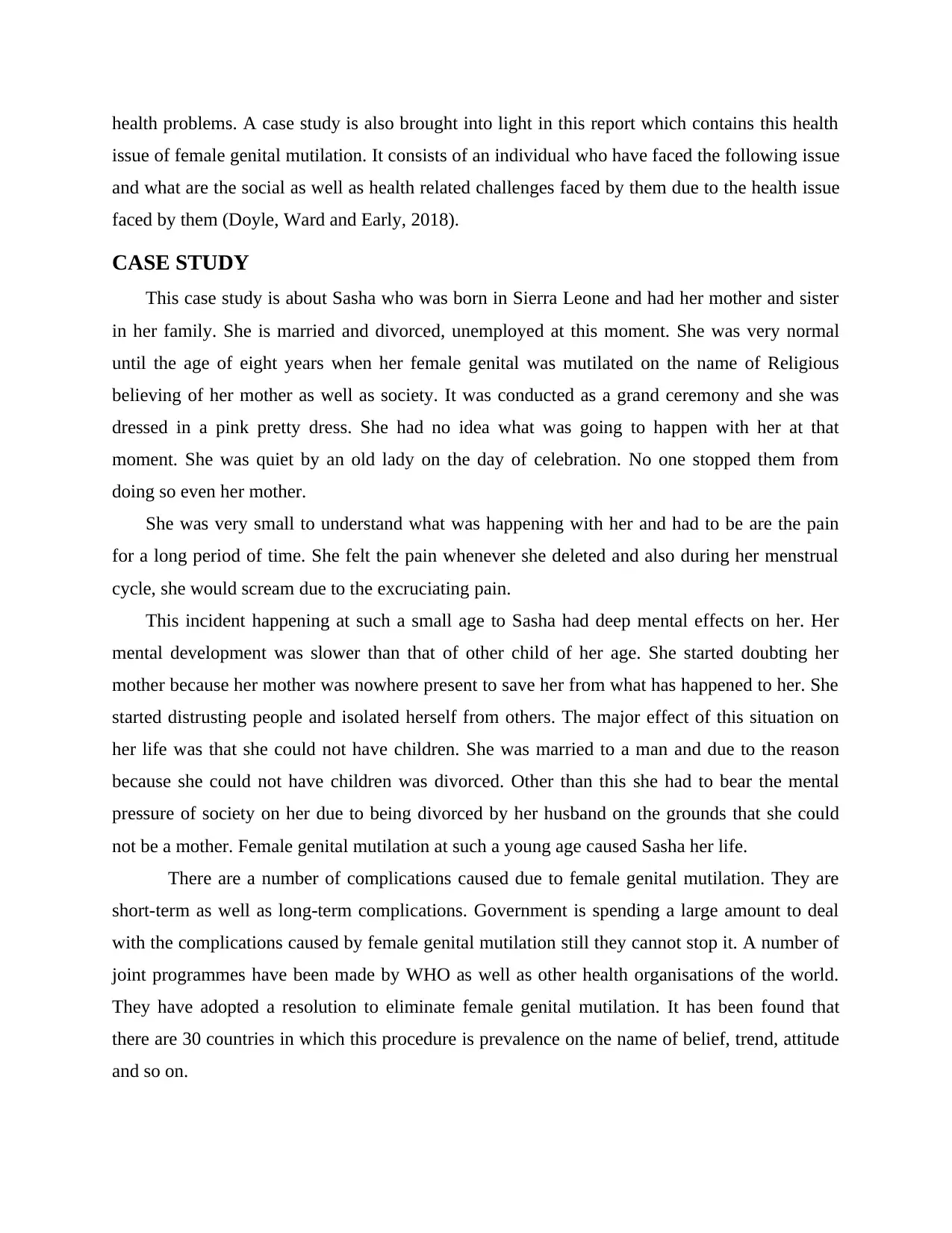
health problems. A case study is also brought into light in this report which contains this health
issue of female genital mutilation. It consists of an individual who have faced the following issue
and what are the social as well as health related challenges faced by them due to the health issue
faced by them (Doyle, Ward and Early, 2018).
CASE STUDY
This case study is about Sasha who was born in Sierra Leone and had her mother and sister
in her family. She is married and divorced, unemployed at this moment. She was very normal
until the age of eight years when her female genital was mutilated on the name of Religious
believing of her mother as well as society. It was conducted as a grand ceremony and she was
dressed in a pink pretty dress. She had no idea what was going to happen with her at that
moment. She was quiet by an old lady on the day of celebration. No one stopped them from
doing so even her mother.
She was very small to understand what was happening with her and had to be are the pain
for a long period of time. She felt the pain whenever she deleted and also during her menstrual
cycle, she would scream due to the excruciating pain.
This incident happening at such a small age to Sasha had deep mental effects on her. Her
mental development was slower than that of other child of her age. She started doubting her
mother because her mother was nowhere present to save her from what has happened to her. She
started distrusting people and isolated herself from others. The major effect of this situation on
her life was that she could not have children. She was married to a man and due to the reason
because she could not have children was divorced. Other than this she had to bear the mental
pressure of society on her due to being divorced by her husband on the grounds that she could
not be a mother. Female genital mutilation at such a young age caused Sasha her life.
There are a number of complications caused due to female genital mutilation. They are
short-term as well as long-term complications. Government is spending a large amount to deal
with the complications caused by female genital mutilation still they cannot stop it. A number of
joint programmes have been made by WHO as well as other health organisations of the world.
They have adopted a resolution to eliminate female genital mutilation. It has been found that
there are 30 countries in which this procedure is prevalence on the name of belief, trend, attitude
and so on.
issue of female genital mutilation. It consists of an individual who have faced the following issue
and what are the social as well as health related challenges faced by them due to the health issue
faced by them (Doyle, Ward and Early, 2018).
CASE STUDY
This case study is about Sasha who was born in Sierra Leone and had her mother and sister
in her family. She is married and divorced, unemployed at this moment. She was very normal
until the age of eight years when her female genital was mutilated on the name of Religious
believing of her mother as well as society. It was conducted as a grand ceremony and she was
dressed in a pink pretty dress. She had no idea what was going to happen with her at that
moment. She was quiet by an old lady on the day of celebration. No one stopped them from
doing so even her mother.
She was very small to understand what was happening with her and had to be are the pain
for a long period of time. She felt the pain whenever she deleted and also during her menstrual
cycle, she would scream due to the excruciating pain.
This incident happening at such a small age to Sasha had deep mental effects on her. Her
mental development was slower than that of other child of her age. She started doubting her
mother because her mother was nowhere present to save her from what has happened to her. She
started distrusting people and isolated herself from others. The major effect of this situation on
her life was that she could not have children. She was married to a man and due to the reason
because she could not have children was divorced. Other than this she had to bear the mental
pressure of society on her due to being divorced by her husband on the grounds that she could
not be a mother. Female genital mutilation at such a young age caused Sasha her life.
There are a number of complications caused due to female genital mutilation. They are
short-term as well as long-term complications. Government is spending a large amount to deal
with the complications caused by female genital mutilation still they cannot stop it. A number of
joint programmes have been made by WHO as well as other health organisations of the world.
They have adopted a resolution to eliminate female genital mutilation. It has been found that
there are 30 countries in which this procedure is prevalence on the name of belief, trend, attitude
and so on.
Paraphrase This Document
Need a fresh take? Get an instant paraphrase of this document with our AI Paraphraser
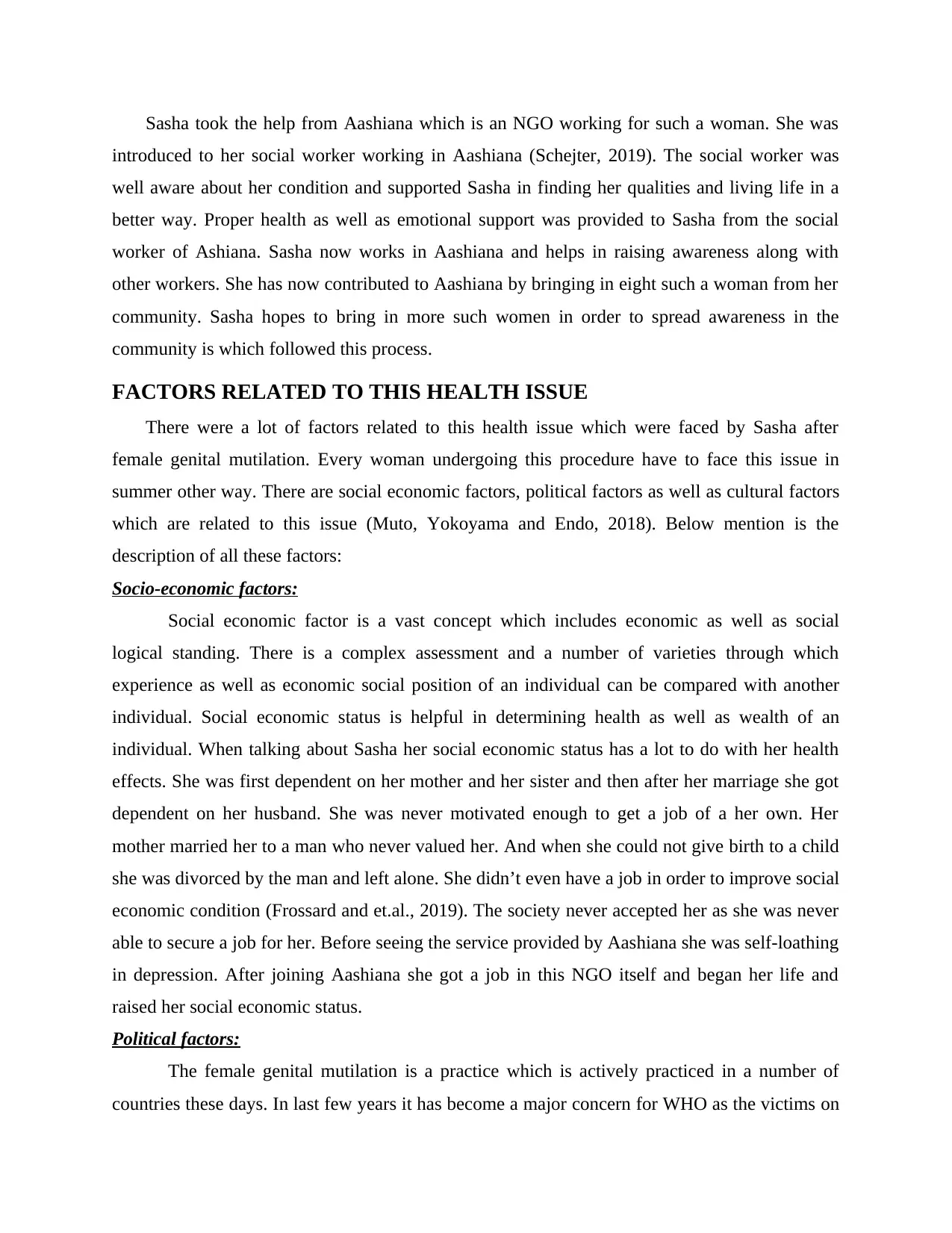
Sasha took the help from Aashiana which is an NGO working for such a woman. She was
introduced to her social worker working in Aashiana (Schejter, 2019). The social worker was
well aware about her condition and supported Sasha in finding her qualities and living life in a
better way. Proper health as well as emotional support was provided to Sasha from the social
worker of Ashiana. Sasha now works in Aashiana and helps in raising awareness along with
other workers. She has now contributed to Aashiana by bringing in eight such a woman from her
community. Sasha hopes to bring in more such women in order to spread awareness in the
community is which followed this process.
FACTORS RELATED TO THIS HEALTH ISSUE
There were a lot of factors related to this health issue which were faced by Sasha after
female genital mutilation. Every woman undergoing this procedure have to face this issue in
summer other way. There are social economic factors, political factors as well as cultural factors
which are related to this issue (Muto, Yokoyama and Endo, 2018). Below mention is the
description of all these factors:
Socio-economic factors:
Social economic factor is a vast concept which includes economic as well as social
logical standing. There is a complex assessment and a number of varieties through which
experience as well as economic social position of an individual can be compared with another
individual. Social economic status is helpful in determining health as well as wealth of an
individual. When talking about Sasha her social economic status has a lot to do with her health
effects. She was first dependent on her mother and her sister and then after her marriage she got
dependent on her husband. She was never motivated enough to get a job of a her own. Her
mother married her to a man who never valued her. And when she could not give birth to a child
she was divorced by the man and left alone. She didn’t even have a job in order to improve social
economic condition (Frossard and et.al., 2019). The society never accepted her as she was never
able to secure a job for her. Before seeing the service provided by Aashiana she was self-loathing
in depression. After joining Aashiana she got a job in this NGO itself and began her life and
raised her social economic status.
Political factors:
The female genital mutilation is a practice which is actively practiced in a number of
countries these days. In last few years it has become a major concern for WHO as the victims on
introduced to her social worker working in Aashiana (Schejter, 2019). The social worker was
well aware about her condition and supported Sasha in finding her qualities and living life in a
better way. Proper health as well as emotional support was provided to Sasha from the social
worker of Ashiana. Sasha now works in Aashiana and helps in raising awareness along with
other workers. She has now contributed to Aashiana by bringing in eight such a woman from her
community. Sasha hopes to bring in more such women in order to spread awareness in the
community is which followed this process.
FACTORS RELATED TO THIS HEALTH ISSUE
There were a lot of factors related to this health issue which were faced by Sasha after
female genital mutilation. Every woman undergoing this procedure have to face this issue in
summer other way. There are social economic factors, political factors as well as cultural factors
which are related to this issue (Muto, Yokoyama and Endo, 2018). Below mention is the
description of all these factors:
Socio-economic factors:
Social economic factor is a vast concept which includes economic as well as social
logical standing. There is a complex assessment and a number of varieties through which
experience as well as economic social position of an individual can be compared with another
individual. Social economic status is helpful in determining health as well as wealth of an
individual. When talking about Sasha her social economic status has a lot to do with her health
effects. She was first dependent on her mother and her sister and then after her marriage she got
dependent on her husband. She was never motivated enough to get a job of a her own. Her
mother married her to a man who never valued her. And when she could not give birth to a child
she was divorced by the man and left alone. She didn’t even have a job in order to improve social
economic condition (Frossard and et.al., 2019). The society never accepted her as she was never
able to secure a job for her. Before seeing the service provided by Aashiana she was self-loathing
in depression. After joining Aashiana she got a job in this NGO itself and began her life and
raised her social economic status.
Political factors:
The female genital mutilation is a practice which is actively practiced in a number of
countries these days. In last few years it has become a major concern for WHO as the victims on
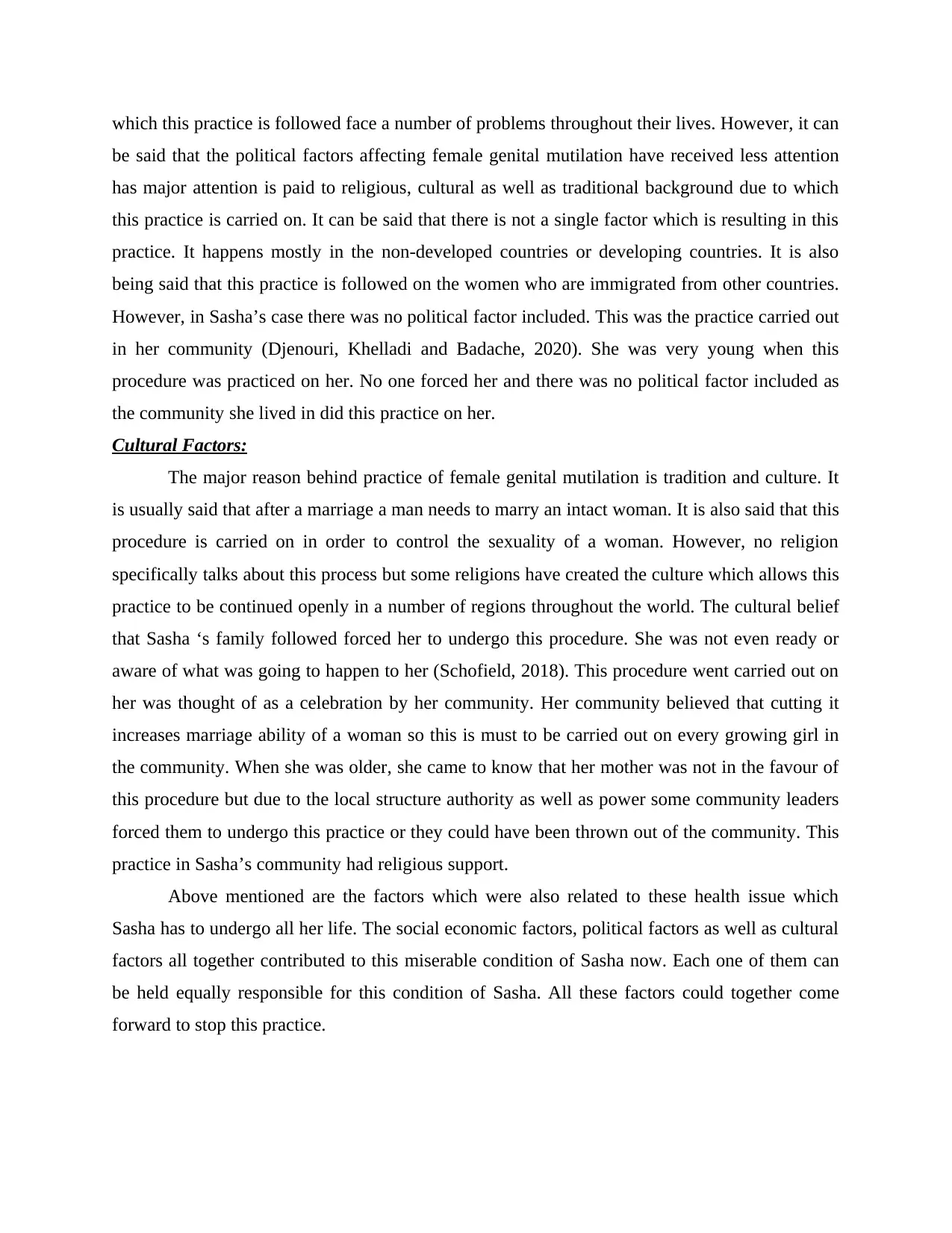
which this practice is followed face a number of problems throughout their lives. However, it can
be said that the political factors affecting female genital mutilation have received less attention
has major attention is paid to religious, cultural as well as traditional background due to which
this practice is carried on. It can be said that there is not a single factor which is resulting in this
practice. It happens mostly in the non-developed countries or developing countries. It is also
being said that this practice is followed on the women who are immigrated from other countries.
However, in Sasha’s case there was no political factor included. This was the practice carried out
in her community (Djenouri, Khelladi and Badache, 2020). She was very young when this
procedure was practiced on her. No one forced her and there was no political factor included as
the community she lived in did this practice on her.
Cultural Factors:
The major reason behind practice of female genital mutilation is tradition and culture. It
is usually said that after a marriage a man needs to marry an intact woman. It is also said that this
procedure is carried on in order to control the sexuality of a woman. However, no religion
specifically talks about this process but some religions have created the culture which allows this
practice to be continued openly in a number of regions throughout the world. The cultural belief
that Sasha ‘s family followed forced her to undergo this procedure. She was not even ready or
aware of what was going to happen to her (Schofield, 2018). This procedure went carried out on
her was thought of as a celebration by her community. Her community believed that cutting it
increases marriage ability of a woman so this is must to be carried out on every growing girl in
the community. When she was older, she came to know that her mother was not in the favour of
this procedure but due to the local structure authority as well as power some community leaders
forced them to undergo this practice or they could have been thrown out of the community. This
practice in Sasha’s community had religious support.
Above mentioned are the factors which were also related to these health issue which
Sasha has to undergo all her life. The social economic factors, political factors as well as cultural
factors all together contributed to this miserable condition of Sasha now. Each one of them can
be held equally responsible for this condition of Sasha. All these factors could together come
forward to stop this practice.
be said that the political factors affecting female genital mutilation have received less attention
has major attention is paid to religious, cultural as well as traditional background due to which
this practice is carried on. It can be said that there is not a single factor which is resulting in this
practice. It happens mostly in the non-developed countries or developing countries. It is also
being said that this practice is followed on the women who are immigrated from other countries.
However, in Sasha’s case there was no political factor included. This was the practice carried out
in her community (Djenouri, Khelladi and Badache, 2020). She was very young when this
procedure was practiced on her. No one forced her and there was no political factor included as
the community she lived in did this practice on her.
Cultural Factors:
The major reason behind practice of female genital mutilation is tradition and culture. It
is usually said that after a marriage a man needs to marry an intact woman. It is also said that this
procedure is carried on in order to control the sexuality of a woman. However, no religion
specifically talks about this process but some religions have created the culture which allows this
practice to be continued openly in a number of regions throughout the world. The cultural belief
that Sasha ‘s family followed forced her to undergo this procedure. She was not even ready or
aware of what was going to happen to her (Schofield, 2018). This procedure went carried out on
her was thought of as a celebration by her community. Her community believed that cutting it
increases marriage ability of a woman so this is must to be carried out on every growing girl in
the community. When she was older, she came to know that her mother was not in the favour of
this procedure but due to the local structure authority as well as power some community leaders
forced them to undergo this practice or they could have been thrown out of the community. This
practice in Sasha’s community had religious support.
Above mentioned are the factors which were also related to these health issue which
Sasha has to undergo all her life. The social economic factors, political factors as well as cultural
factors all together contributed to this miserable condition of Sasha now. Each one of them can
be held equally responsible for this condition of Sasha. All these factors could together come
forward to stop this practice.
⊘ This is a preview!⊘
Do you want full access?
Subscribe today to unlock all pages.

Trusted by 1+ million students worldwide
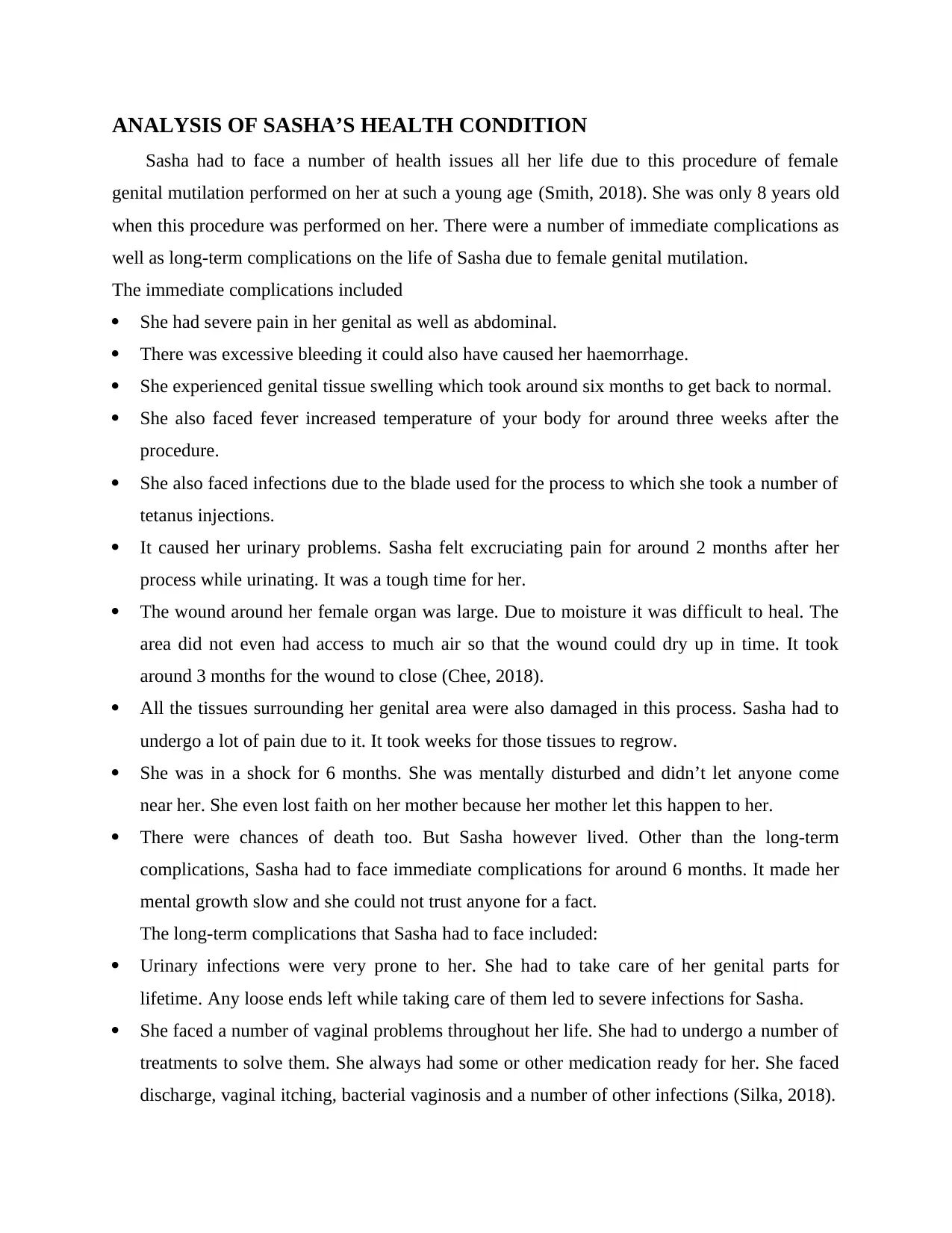
ANALYSIS OF SASHA’S HEALTH CONDITION
Sasha had to face a number of health issues all her life due to this procedure of female
genital mutilation performed on her at such a young age (Smith, 2018). She was only 8 years old
when this procedure was performed on her. There were a number of immediate complications as
well as long-term complications on the life of Sasha due to female genital mutilation.
The immediate complications included
She had severe pain in her genital as well as abdominal.
There was excessive bleeding it could also have caused her haemorrhage.
She experienced genital tissue swelling which took around six months to get back to normal.
She also faced fever increased temperature of your body for around three weeks after the
procedure.
She also faced infections due to the blade used for the process to which she took a number of
tetanus injections.
It caused her urinary problems. Sasha felt excruciating pain for around 2 months after her
process while urinating. It was a tough time for her.
The wound around her female organ was large. Due to moisture it was difficult to heal. The
area did not even had access to much air so that the wound could dry up in time. It took
around 3 months for the wound to close (Chee, 2018).
All the tissues surrounding her genital area were also damaged in this process. Sasha had to
undergo a lot of pain due to it. It took weeks for those tissues to regrow.
She was in a shock for 6 months. She was mentally disturbed and didn’t let anyone come
near her. She even lost faith on her mother because her mother let this happen to her.
There were chances of death too. But Sasha however lived. Other than the long-term
complications, Sasha had to face immediate complications for around 6 months. It made her
mental growth slow and she could not trust anyone for a fact.
The long-term complications that Sasha had to face included:
Urinary infections were very prone to her. She had to take care of her genital parts for
lifetime. Any loose ends left while taking care of them led to severe infections for Sasha.
She faced a number of vaginal problems throughout her life. She had to undergo a number of
treatments to solve them. She always had some or other medication ready for her. She faced
discharge, vaginal itching, bacterial vaginosis and a number of other infections (Silka, 2018).
Sasha had to face a number of health issues all her life due to this procedure of female
genital mutilation performed on her at such a young age (Smith, 2018). She was only 8 years old
when this procedure was performed on her. There were a number of immediate complications as
well as long-term complications on the life of Sasha due to female genital mutilation.
The immediate complications included
She had severe pain in her genital as well as abdominal.
There was excessive bleeding it could also have caused her haemorrhage.
She experienced genital tissue swelling which took around six months to get back to normal.
She also faced fever increased temperature of your body for around three weeks after the
procedure.
She also faced infections due to the blade used for the process to which she took a number of
tetanus injections.
It caused her urinary problems. Sasha felt excruciating pain for around 2 months after her
process while urinating. It was a tough time for her.
The wound around her female organ was large. Due to moisture it was difficult to heal. The
area did not even had access to much air so that the wound could dry up in time. It took
around 3 months for the wound to close (Chee, 2018).
All the tissues surrounding her genital area were also damaged in this process. Sasha had to
undergo a lot of pain due to it. It took weeks for those tissues to regrow.
She was in a shock for 6 months. She was mentally disturbed and didn’t let anyone come
near her. She even lost faith on her mother because her mother let this happen to her.
There were chances of death too. But Sasha however lived. Other than the long-term
complications, Sasha had to face immediate complications for around 6 months. It made her
mental growth slow and she could not trust anyone for a fact.
The long-term complications that Sasha had to face included:
Urinary infections were very prone to her. She had to take care of her genital parts for
lifetime. Any loose ends left while taking care of them led to severe infections for Sasha.
She faced a number of vaginal problems throughout her life. She had to undergo a number of
treatments to solve them. She always had some or other medication ready for her. She faced
discharge, vaginal itching, bacterial vaginosis and a number of other infections (Silka, 2018).
Paraphrase This Document
Need a fresh take? Get an instant paraphrase of this document with our AI Paraphraser
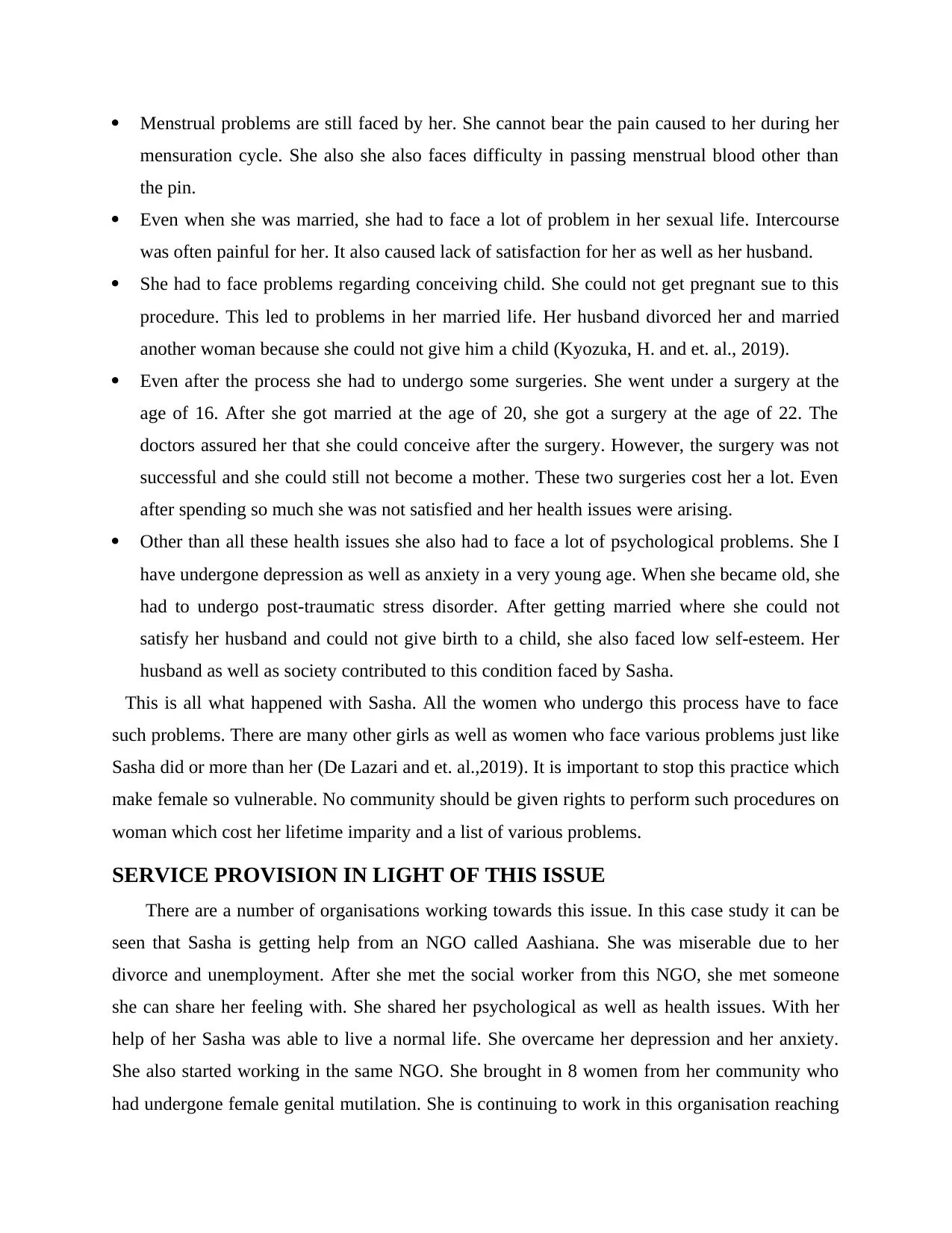
Menstrual problems are still faced by her. She cannot bear the pain caused to her during her
mensuration cycle. She also she also faces difficulty in passing menstrual blood other than
the pin.
Even when she was married, she had to face a lot of problem in her sexual life. Intercourse
was often painful for her. It also caused lack of satisfaction for her as well as her husband.
She had to face problems regarding conceiving child. She could not get pregnant sue to this
procedure. This led to problems in her married life. Her husband divorced her and married
another woman because she could not give him a child (Kyozuka, H. and et. al., 2019).
Even after the process she had to undergo some surgeries. She went under a surgery at the
age of 16. After she got married at the age of 20, she got a surgery at the age of 22. The
doctors assured her that she could conceive after the surgery. However, the surgery was not
successful and she could still not become a mother. These two surgeries cost her a lot. Even
after spending so much she was not satisfied and her health issues were arising.
Other than all these health issues she also had to face a lot of psychological problems. She I
have undergone depression as well as anxiety in a very young age. When she became old, she
had to undergo post-traumatic stress disorder. After getting married where she could not
satisfy her husband and could not give birth to a child, she also faced low self-esteem. Her
husband as well as society contributed to this condition faced by Sasha.
This is all what happened with Sasha. All the women who undergo this process have to face
such problems. There are many other girls as well as women who face various problems just like
Sasha did or more than her (De Lazari and et. al.,2019). It is important to stop this practice which
make female so vulnerable. No community should be given rights to perform such procedures on
woman which cost her lifetime imparity and a list of various problems.
SERVICE PROVISION IN LIGHT OF THIS ISSUE
There are a number of organisations working towards this issue. In this case study it can be
seen that Sasha is getting help from an NGO called Aashiana. She was miserable due to her
divorce and unemployment. After she met the social worker from this NGO, she met someone
she can share her feeling with. She shared her psychological as well as health issues. With her
help of her Sasha was able to live a normal life. She overcame her depression and her anxiety.
She also started working in the same NGO. She brought in 8 women from her community who
had undergone female genital mutilation. She is continuing to work in this organisation reaching
mensuration cycle. She also she also faces difficulty in passing menstrual blood other than
the pin.
Even when she was married, she had to face a lot of problem in her sexual life. Intercourse
was often painful for her. It also caused lack of satisfaction for her as well as her husband.
She had to face problems regarding conceiving child. She could not get pregnant sue to this
procedure. This led to problems in her married life. Her husband divorced her and married
another woman because she could not give him a child (Kyozuka, H. and et. al., 2019).
Even after the process she had to undergo some surgeries. She went under a surgery at the
age of 16. After she got married at the age of 20, she got a surgery at the age of 22. The
doctors assured her that she could conceive after the surgery. However, the surgery was not
successful and she could still not become a mother. These two surgeries cost her a lot. Even
after spending so much she was not satisfied and her health issues were arising.
Other than all these health issues she also had to face a lot of psychological problems. She I
have undergone depression as well as anxiety in a very young age. When she became old, she
had to undergo post-traumatic stress disorder. After getting married where she could not
satisfy her husband and could not give birth to a child, she also faced low self-esteem. Her
husband as well as society contributed to this condition faced by Sasha.
This is all what happened with Sasha. All the women who undergo this process have to face
such problems. There are many other girls as well as women who face various problems just like
Sasha did or more than her (De Lazari and et. al.,2019). It is important to stop this practice which
make female so vulnerable. No community should be given rights to perform such procedures on
woman which cost her lifetime imparity and a list of various problems.
SERVICE PROVISION IN LIGHT OF THIS ISSUE
There are a number of organisations working towards this issue. In this case study it can be
seen that Sasha is getting help from an NGO called Aashiana. She was miserable due to her
divorce and unemployment. After she met the social worker from this NGO, she met someone
she can share her feeling with. She shared her psychological as well as health issues. With her
help of her Sasha was able to live a normal life. She overcame her depression and her anxiety.
She also started working in the same NGO. She brought in 8 women from her community who
had undergone female genital mutilation. She is continuing to work in this organisation reaching
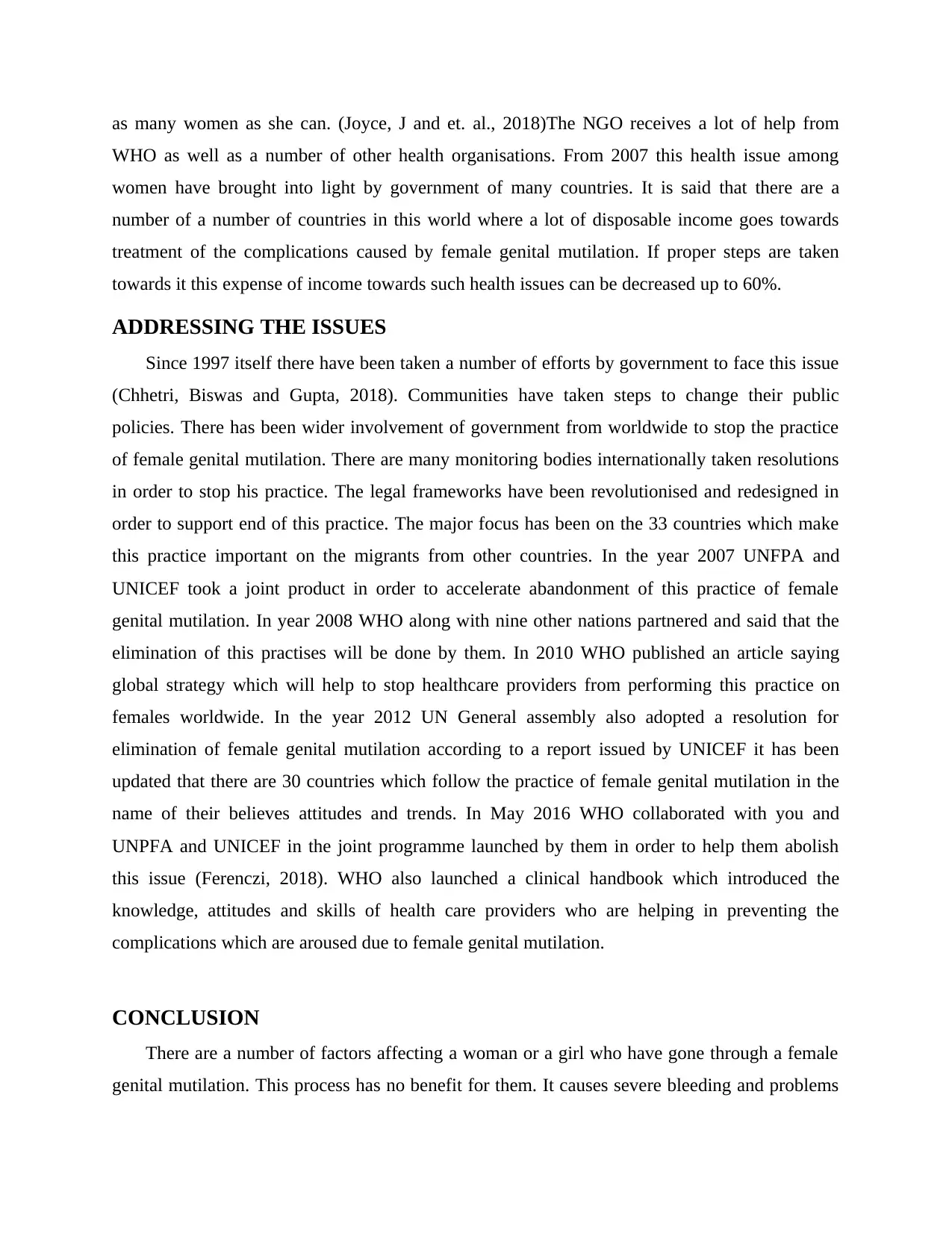
as many women as she can. (Joyce, J and et. al., 2018)The NGO receives a lot of help from
WHO as well as a number of other health organisations. From 2007 this health issue among
women have brought into light by government of many countries. It is said that there are a
number of a number of countries in this world where a lot of disposable income goes towards
treatment of the complications caused by female genital mutilation. If proper steps are taken
towards it this expense of income towards such health issues can be decreased up to 60%.
ADDRESSING THE ISSUES
Since 1997 itself there have been taken a number of efforts by government to face this issue
(Chhetri, Biswas and Gupta, 2018). Communities have taken steps to change their public
policies. There has been wider involvement of government from worldwide to stop the practice
of female genital mutilation. There are many monitoring bodies internationally taken resolutions
in order to stop his practice. The legal frameworks have been revolutionised and redesigned in
order to support end of this practice. The major focus has been on the 33 countries which make
this practice important on the migrants from other countries. In the year 2007 UNFPA and
UNICEF took a joint product in order to accelerate abandonment of this practice of female
genital mutilation. In year 2008 WHO along with nine other nations partnered and said that the
elimination of this practises will be done by them. In 2010 WHO published an article saying
global strategy which will help to stop healthcare providers from performing this practice on
females worldwide. In the year 2012 UN General assembly also adopted a resolution for
elimination of female genital mutilation according to a report issued by UNICEF it has been
updated that there are 30 countries which follow the practice of female genital mutilation in the
name of their believes attitudes and trends. In May 2016 WHO collaborated with you and
UNPFA and UNICEF in the joint programme launched by them in order to help them abolish
this issue (Ferenczi, 2018). WHO also launched a clinical handbook which introduced the
knowledge, attitudes and skills of health care providers who are helping in preventing the
complications which are aroused due to female genital mutilation.
CONCLUSION
There are a number of factors affecting a woman or a girl who have gone through a female
genital mutilation. This process has no benefit for them. It causes severe bleeding and problems
WHO as well as a number of other health organisations. From 2007 this health issue among
women have brought into light by government of many countries. It is said that there are a
number of a number of countries in this world where a lot of disposable income goes towards
treatment of the complications caused by female genital mutilation. If proper steps are taken
towards it this expense of income towards such health issues can be decreased up to 60%.
ADDRESSING THE ISSUES
Since 1997 itself there have been taken a number of efforts by government to face this issue
(Chhetri, Biswas and Gupta, 2018). Communities have taken steps to change their public
policies. There has been wider involvement of government from worldwide to stop the practice
of female genital mutilation. There are many monitoring bodies internationally taken resolutions
in order to stop his practice. The legal frameworks have been revolutionised and redesigned in
order to support end of this practice. The major focus has been on the 33 countries which make
this practice important on the migrants from other countries. In the year 2007 UNFPA and
UNICEF took a joint product in order to accelerate abandonment of this practice of female
genital mutilation. In year 2008 WHO along with nine other nations partnered and said that the
elimination of this practises will be done by them. In 2010 WHO published an article saying
global strategy which will help to stop healthcare providers from performing this practice on
females worldwide. In the year 2012 UN General assembly also adopted a resolution for
elimination of female genital mutilation according to a report issued by UNICEF it has been
updated that there are 30 countries which follow the practice of female genital mutilation in the
name of their believes attitudes and trends. In May 2016 WHO collaborated with you and
UNPFA and UNICEF in the joint programme launched by them in order to help them abolish
this issue (Ferenczi, 2018). WHO also launched a clinical handbook which introduced the
knowledge, attitudes and skills of health care providers who are helping in preventing the
complications which are aroused due to female genital mutilation.
CONCLUSION
There are a number of factors affecting a woman or a girl who have gone through a female
genital mutilation. This process has no benefit for them. It causes severe bleeding and problems
⊘ This is a preview!⊘
Do you want full access?
Subscribe today to unlock all pages.

Trusted by 1+ million students worldwide
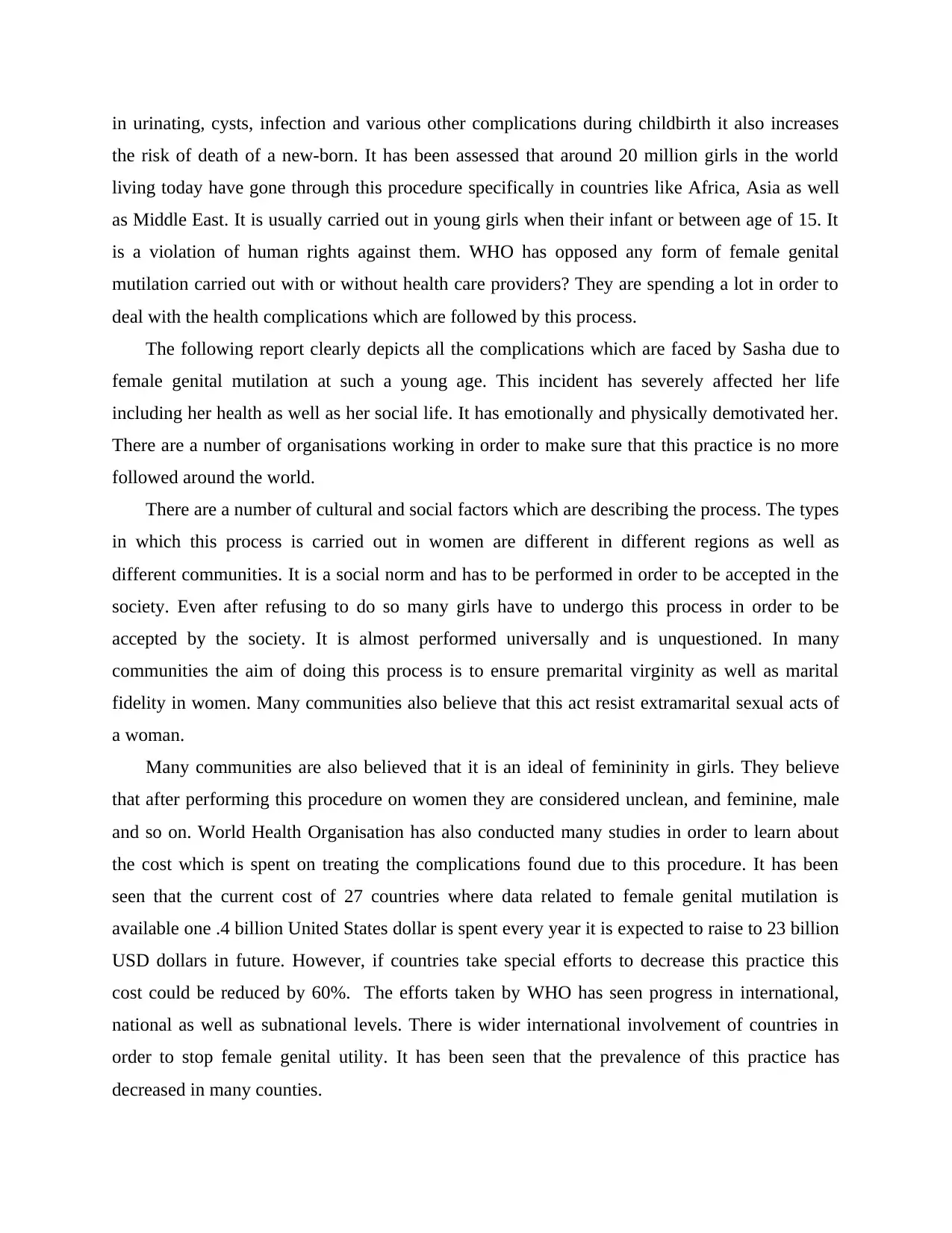
in urinating, cysts, infection and various other complications during childbirth it also increases
the risk of death of a new-born. It has been assessed that around 20 million girls in the world
living today have gone through this procedure specifically in countries like Africa, Asia as well
as Middle East. It is usually carried out in young girls when their infant or between age of 15. It
is a violation of human rights against them. WHO has opposed any form of female genital
mutilation carried out with or without health care providers? They are spending a lot in order to
deal with the health complications which are followed by this process.
The following report clearly depicts all the complications which are faced by Sasha due to
female genital mutilation at such a young age. This incident has severely affected her life
including her health as well as her social life. It has emotionally and physically demotivated her.
There are a number of organisations working in order to make sure that this practice is no more
followed around the world.
There are a number of cultural and social factors which are describing the process. The types
in which this process is carried out in women are different in different regions as well as
different communities. It is a social norm and has to be performed in order to be accepted in the
society. Even after refusing to do so many girls have to undergo this process in order to be
accepted by the society. It is almost performed universally and is unquestioned. In many
communities the aim of doing this process is to ensure premarital virginity as well as marital
fidelity in women. Many communities also believe that this act resist extramarital sexual acts of
a woman.
Many communities are also believed that it is an ideal of femininity in girls. They believe
that after performing this procedure on women they are considered unclean, and feminine, male
and so on. World Health Organisation has also conducted many studies in order to learn about
the cost which is spent on treating the complications found due to this procedure. It has been
seen that the current cost of 27 countries where data related to female genital mutilation is
available one .4 billion United States dollar is spent every year it is expected to raise to 23 billion
USD dollars in future. However, if countries take special efforts to decrease this practice this
cost could be reduced by 60%. The efforts taken by WHO has seen progress in international,
national as well as subnational levels. There is wider international involvement of countries in
order to stop female genital utility. It has been seen that the prevalence of this practice has
decreased in many counties.
the risk of death of a new-born. It has been assessed that around 20 million girls in the world
living today have gone through this procedure specifically in countries like Africa, Asia as well
as Middle East. It is usually carried out in young girls when their infant or between age of 15. It
is a violation of human rights against them. WHO has opposed any form of female genital
mutilation carried out with or without health care providers? They are spending a lot in order to
deal with the health complications which are followed by this process.
The following report clearly depicts all the complications which are faced by Sasha due to
female genital mutilation at such a young age. This incident has severely affected her life
including her health as well as her social life. It has emotionally and physically demotivated her.
There are a number of organisations working in order to make sure that this practice is no more
followed around the world.
There are a number of cultural and social factors which are describing the process. The types
in which this process is carried out in women are different in different regions as well as
different communities. It is a social norm and has to be performed in order to be accepted in the
society. Even after refusing to do so many girls have to undergo this process in order to be
accepted by the society. It is almost performed universally and is unquestioned. In many
communities the aim of doing this process is to ensure premarital virginity as well as marital
fidelity in women. Many communities also believe that this act resist extramarital sexual acts of
a woman.
Many communities are also believed that it is an ideal of femininity in girls. They believe
that after performing this procedure on women they are considered unclean, and feminine, male
and so on. World Health Organisation has also conducted many studies in order to learn about
the cost which is spent on treating the complications found due to this procedure. It has been
seen that the current cost of 27 countries where data related to female genital mutilation is
available one .4 billion United States dollar is spent every year it is expected to raise to 23 billion
USD dollars in future. However, if countries take special efforts to decrease this practice this
cost could be reduced by 60%. The efforts taken by WHO has seen progress in international,
national as well as subnational levels. There is wider international involvement of countries in
order to stop female genital utility. It has been seen that the prevalence of this practice has
decreased in many counties.
Paraphrase This Document
Need a fresh take? Get an instant paraphrase of this document with our AI Paraphraser

REFERENCES
Books and Journals
Germov, J., 2019. Imagining health problems as social issues. In Second opinion: An
introduction to health sociology (pp. 2-23). Oxford University Press, USA.
Books and Journals
Germov, J., 2019. Imagining health problems as social issues. In Second opinion: An
introduction to health sociology (pp. 2-23). Oxford University Press, USA.
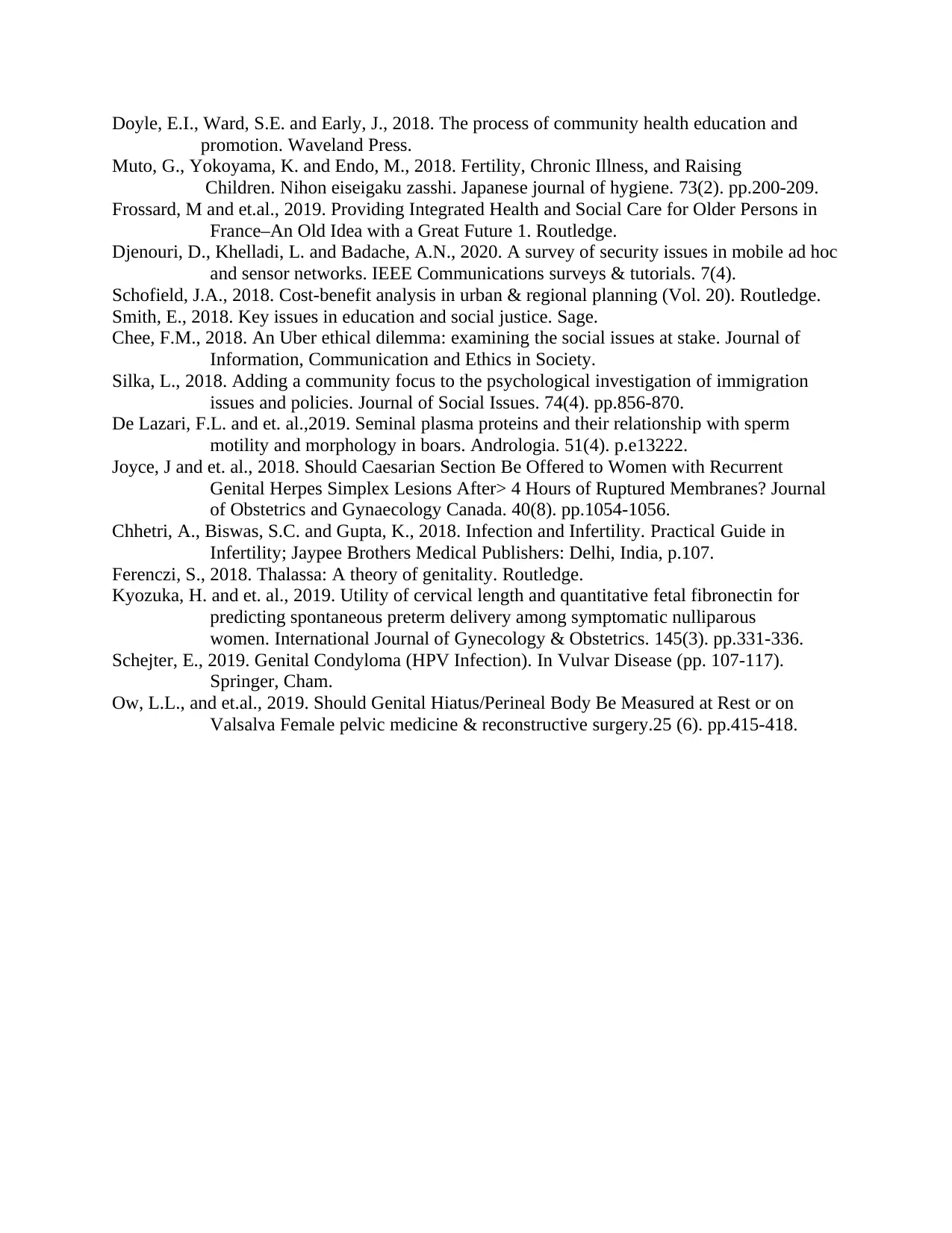
Doyle, E.I., Ward, S.E. and Early, J., 2018. The process of community health education and
promotion. Waveland Press.
Muto, G., Yokoyama, K. and Endo, M., 2018. Fertility, Chronic Illness, and Raising
Children. Nihon eiseigaku zasshi. Japanese journal of hygiene. 73(2). pp.200-209.
Frossard, M and et.al., 2019. Providing Integrated Health and Social Care for Older Persons in
France–An Old Idea with a Great Future 1. Routledge.
Djenouri, D., Khelladi, L. and Badache, A.N., 2020. A survey of security issues in mobile ad hoc
and sensor networks. IEEE Communications surveys & tutorials. 7(4).
Schofield, J.A., 2018. Cost-benefit analysis in urban & regional planning (Vol. 20). Routledge.
Smith, E., 2018. Key issues in education and social justice. Sage.
Chee, F.M., 2018. An Uber ethical dilemma: examining the social issues at stake. Journal of
Information, Communication and Ethics in Society.
Silka, L., 2018. Adding a community focus to the psychological investigation of immigration
issues and policies. Journal of Social Issues. 74(4). pp.856-870.
De Lazari, F.L. and et. al.,2019. Seminal plasma proteins and their relationship with sperm
motility and morphology in boars. Andrologia. 51(4). p.e13222.
Joyce, J and et. al., 2018. Should Caesarian Section Be Offered to Women with Recurrent
Genital Herpes Simplex Lesions After> 4 Hours of Ruptured Membranes? Journal
of Obstetrics and Gynaecology Canada. 40(8). pp.1054-1056.
Chhetri, A., Biswas, S.C. and Gupta, K., 2018. Infection and Infertility. Practical Guide in
Infertility; Jaypee Brothers Medical Publishers: Delhi, India, p.107.
Ferenczi, S., 2018. Thalassa: A theory of genitality. Routledge.
Kyozuka, H. and et. al., 2019. Utility of cervical length and quantitative fetal fibronectin for
predicting spontaneous preterm delivery among symptomatic nulliparous
women. International Journal of Gynecology & Obstetrics. 145(3). pp.331-336.
Schejter, E., 2019. Genital Condyloma (HPV Infection). In Vulvar Disease (pp. 107-117).
Springer, Cham.
Ow, L.L., and et.al., 2019. Should Genital Hiatus/Perineal Body Be Measured at Rest or on
Valsalva Female pelvic medicine & reconstructive surgery.25 (6). pp.415-418.
promotion. Waveland Press.
Muto, G., Yokoyama, K. and Endo, M., 2018. Fertility, Chronic Illness, and Raising
Children. Nihon eiseigaku zasshi. Japanese journal of hygiene. 73(2). pp.200-209.
Frossard, M and et.al., 2019. Providing Integrated Health and Social Care for Older Persons in
France–An Old Idea with a Great Future 1. Routledge.
Djenouri, D., Khelladi, L. and Badache, A.N., 2020. A survey of security issues in mobile ad hoc
and sensor networks. IEEE Communications surveys & tutorials. 7(4).
Schofield, J.A., 2018. Cost-benefit analysis in urban & regional planning (Vol. 20). Routledge.
Smith, E., 2018. Key issues in education and social justice. Sage.
Chee, F.M., 2018. An Uber ethical dilemma: examining the social issues at stake. Journal of
Information, Communication and Ethics in Society.
Silka, L., 2018. Adding a community focus to the psychological investigation of immigration
issues and policies. Journal of Social Issues. 74(4). pp.856-870.
De Lazari, F.L. and et. al.,2019. Seminal plasma proteins and their relationship with sperm
motility and morphology in boars. Andrologia. 51(4). p.e13222.
Joyce, J and et. al., 2018. Should Caesarian Section Be Offered to Women with Recurrent
Genital Herpes Simplex Lesions After> 4 Hours of Ruptured Membranes? Journal
of Obstetrics and Gynaecology Canada. 40(8). pp.1054-1056.
Chhetri, A., Biswas, S.C. and Gupta, K., 2018. Infection and Infertility. Practical Guide in
Infertility; Jaypee Brothers Medical Publishers: Delhi, India, p.107.
Ferenczi, S., 2018. Thalassa: A theory of genitality. Routledge.
Kyozuka, H. and et. al., 2019. Utility of cervical length and quantitative fetal fibronectin for
predicting spontaneous preterm delivery among symptomatic nulliparous
women. International Journal of Gynecology & Obstetrics. 145(3). pp.331-336.
Schejter, E., 2019. Genital Condyloma (HPV Infection). In Vulvar Disease (pp. 107-117).
Springer, Cham.
Ow, L.L., and et.al., 2019. Should Genital Hiatus/Perineal Body Be Measured at Rest or on
Valsalva Female pelvic medicine & reconstructive surgery.25 (6). pp.415-418.
⊘ This is a preview!⊘
Do you want full access?
Subscribe today to unlock all pages.

Trusted by 1+ million students worldwide
1 out of 13
Related Documents
Your All-in-One AI-Powered Toolkit for Academic Success.
+13062052269
info@desklib.com
Available 24*7 on WhatsApp / Email
![[object Object]](/_next/static/media/star-bottom.7253800d.svg)
Unlock your academic potential
Copyright © 2020–2025 A2Z Services. All Rights Reserved. Developed and managed by ZUCOL.




